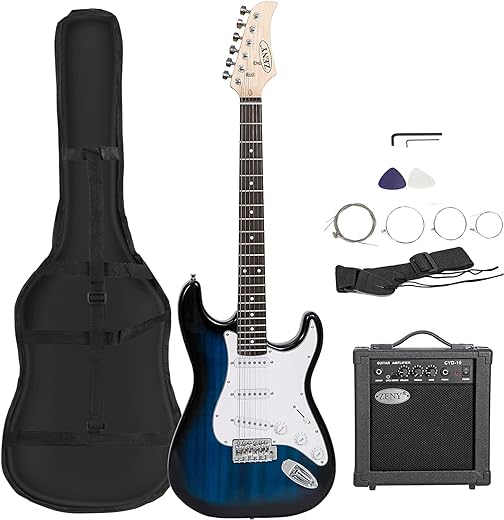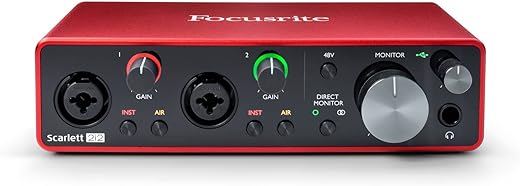How to choose an electric guitar?
How to Choose an Electric Guitar” is a comprehensive step-by-step guide that will assist you in selecting the ideal electric guitar for your needs. This post will help address the problem you face when trying to choose an electric guitar by offering practical advice and expert recommendations. Did you know that there are over 20 different types of electric guitars available? With this guide, you can navigate through the vast options and make a confident choice.
Top-selling electric guitars for all players
Consider your playing style and genre
Identifying the type of music you want to play and determining the playing style that suits you best is crucial when choosing an electric guitar. Start by researching different genres to have a clear understanding of the music you are interested in playing. Whether it’s rock, blues, jazz, country, or metal, each genre has its distinct characteristics and demands specific playing techniques.
Next, consider your personal playing style. Are you more inclined towards fast and aggressive playing with heavy distortion, or do you prefer a cleaner and melodic sound? This will help you determine the type of guitar that complements your style. For example, if you’re into fast-paced rock or metal, a solid body electric guitar with humbucker pickups can provide the power and sustain you need. On the other hand, if you are into jazz or blues, you might lean towards a semi-hollow or hollow body guitar for its warmer and more resonant tones.
By understanding your preferred genre and playing style, you can narrow down your options and make an informed decision when choosing an electric guitar. Experimenting with different guitars and playing styles can also help you discover new sounds and expand your musical horizons. Remember, finding the right guitar that suits your musical preferences and playing style is essential for a more enjoyable and fulfilling playing experience.
Set a budget
To set a budget for purchasing an electric guitar, start by deciding on a comfortable budget range. This will help you narrow down your options and focus on guitars that meet your financial requirements. For example, you could set a budget range of $500 to $1000. By doing so, you will eliminate guitars that are priced below or above this range, saving you time and effort in your search.
To decide on a budget range, consider factors such as your level of expertise, intended use, and personal preferences. If you’re a beginner or just starting out, you may want to start with a lower budget range to avoid overspending on a guitar you may not fully utilize. On the other hand, if you’re an experienced player or plan to use the guitar for professional purposes, you might be willing to invest in a higher-end instrument within a larger budget range.
Remember, having a budget range in mind will not only help you focus your search but also ensure that you don’t overspend or compromise on quality. So take some time to assess your financial situation, research the price ranges of electric guitars, and determine a budget range that you are comfortable with.
Try out different models
To try out different electric guitar models, follow these steps:
- Step 1: Visit a local music store or guitar shop.
- Step 2: Approach the electric guitar section and ask for assistance, if needed.
- Step 3: Start by assessing the comfort of each guitar you are interested in. Hold the instrument and see how it feels against your body. Take note of its weight and body shape.
- Step 4: Test the playability of the guitars by playing a few chords or scales. Check if the neck feels comfortable in your hand and if the strings are at a suitable height for your playing style.
- Step 5: Pay attention to the sound quality of each guitar. Plug the instrument into an amplifier and experiment with different pickups and controls. Play various genres and styles to get a feel for the guitar’s versatility.
- Step 6: Take your time to compare and contrast the different models based on factors like comfort, playability, and sound quality.
- Step 7: Repeat the process with as many electric guitar models as you wish until you find one that suits your preferences.
Remember, trying out different models is an essential step in finding the electric guitar that best matches your playing style and sound preferences. Have fun exploring and experimenting with the guitars!
Consider the guitar's construction and materials
When considering a guitar, it is important to explore the construction and materials used in its body, neck, and fretboard. These factors play a crucial role in determining the tone and playability of the instrument. Here’s a step-by-step guide to help you understand and compare different options to find the right combination for your preferences:
- Research wood types: Different types of wood have distinct tonal characteristics. For example, mahogany is known for its warm and rich tone, while maple offers brightness and clarity. Explore the properties of various woods commonly used in guitar construction, such as spruce, cedar, rosewood, and ebony.
- Consider scale length: The scale length of a guitar refers to the vibrating length of the strings. It influences the tension and feel of the instrument, as well as the overall sound. Longer scale lengths generally result in more sustain and tighter string tension, while shorter scale lengths can facilitate easier bending and a looser feel. Try out guitars with different scale lengths to see which suits your playing style and comfort.
- Evaluate body shape: Guitar body shapes, such as dreadnought, concert, or jumbo, can significantly affect the tone and projection. Each shape has its own unique characteristics, so it’s important to experiment and find one that resonates with your desired sound. For example, a dreadnought body shape offers a balanced tone with strong bass response, while a concert body shape is more suited for fingerstyle playing with a focused mid-range.
- Assess neck profile and material: The neck profile determines the shape and thickness of the neck, which in turn affects how comfortable it feels in your hand. Some common neck shapes include C-shaped, V-shaped, and U-shaped profiles. Additionally, pay attention to the neck material, such as maple or mahogany, as it can impact the overall feel and stability of the instrument.
- Examine fretboard material: The fretboard material not only affects the feel under your fingers but also contributes to the overall tone. Common fretboard materials include rosewood, ebony, and maple. Each material provides a different tactile experience and can influence the brightness or warmth of the guitar’s sound.
By exploring and comparing the construction and materials used in the guitar’s body, neck, and fretboard, you can make an informed decision that aligns with your musical preferences. Remember to try out different options and consult with knowledgeable professionals to find the right combination for your playing style and desired tone.
Check for quality and craftsmanship
Inspect the guitar thoroughly to identify any signs of poor craftsmanship. Start by checking the frets for evenness. Run your fingers along the edges of the fretboard to feel for any sharp or protruding edges. Uneven frets can affect the playability of the instrument, causing buzzing or intonation issues. Next, examine the hardware, including the tuning pegs, bridge, and strap buttons. Make sure they are securely fastened with no signs of looseness. Loose hardware can lead to tuning instability or even structural damage over time.
Pay close attention to the guitar’s finish. Look for any flaws such as bubbles, cracks, or uneven coating. These imperfections not only affect the aesthetics but can also indicate poor quality control during manufacturing. A smooth and well-applied finish is a good indicator of a well-made instrument.
When choosing a guitar, it is advisable to opt for reputable brands known for their quality control and attention to detail. Brands like Gibson, Fender, Taylor, or Martin have a long-standing reputation for producing reliable instruments. However, it’s always a good idea to read reviews and seek recommendations from trusted sources before making a final decision.
By following these steps and being mindful of craftsmanship, you can ensure you choose a guitar that is well-built and will provide you with years of playing enjoyment.
Consider additional features and accessories
Consider additional features and accessories to enhance your playing experience. Evaluate your needs and preferences to make an informed decision. Look for built-in effects, such as reverb or distortion, that can add depth and variety to your sound. For example, a guitar with a built-in tremolo system can create a pulsating effect that adds excitement to your playing. Additionally, consider the availability of spare parts for your instrument. This is especially important if you plan on keeping your instrument for a long time and want to be able to easily replace any worn-out or broken components. By considering these factors, you can choose a guitar that meets your specific requirements and allows you to fully enjoy your playing experience.
Final thoughts and recommendations
In conclusion, selecting the right electric guitar for you can be a straightforward process if you follow the steps outlined in this blog post. By considering factors such as your playing style, budget, and preferences, you can make an informed decision. Take into account aspects like genre, playability, construction, quality, and any additional features that may enhance your playing experience. Armed with this knowledge, you can embark on your guitar hunting journey with confidence. Happy guitar hunting!
















I tried following the steps, but I’m having trouble checking for quality and craftsmanship. What are some red flags to look out for? Any tips on how to spot a well-made electric guitar?
Quality and craftsmanship are important factors to consider. Some red flags include uneven frets, loose hardware, or poor finish. Look for smooth edges, solid construction, and attention to detail. I’ll consider writing an article with more specific tips on how to spot a well-made electric guitar. Thanks for your question!
I’ve been playing the electric guitar for a few years now and I found that trying out different models is crucial. Each guitar has its own unique feel and sound. It’s also important to consider the weight and balance of the guitar for comfortable playing.
Absolutely! Trying out different models is essential to find the perfect match. Weight and balance are often overlooked but can make a big difference in playing comfort. Thanks for sharing your experience!
I followed your guide and found a great electric guitar within my budget. However, I’m confused about the additional features and accessories. Can you provide some recommendations or guidance on what to look for?
Certainly! Additional features like coil-tapping, built-in effects, or locking tuners can enhance your playing experience. As for accessories, a good quality gig bag or case, a strap, and a tuner are essential. I’ll consider writing an article specifically focusing on additional features and accessories.
Thanks for this guide! I used it to choose my first electric guitar and I’m loving it. I would like to suggest a topic on how to choose the right amplifier to pair with the electric guitar.
Thank you for your suggestion! Choosing the right amplifier is indeed an important aspect. I’ll definitely consider writing an article on that topic.
Great guide! I followed your steps and found the perfect electric guitar for my playing style and genre. I would love to see an article about different types of pickups and how they affect the sound.
When considering the guitar’s construction and materials, I highly recommend looking into the neck and fretboard material. Different materials can affect the playability and tone.
This guide is really helpful. Can you please write a follow-up article on how to maintain and care for an electric guitar? I want to make sure I keep my new guitar in top shape.